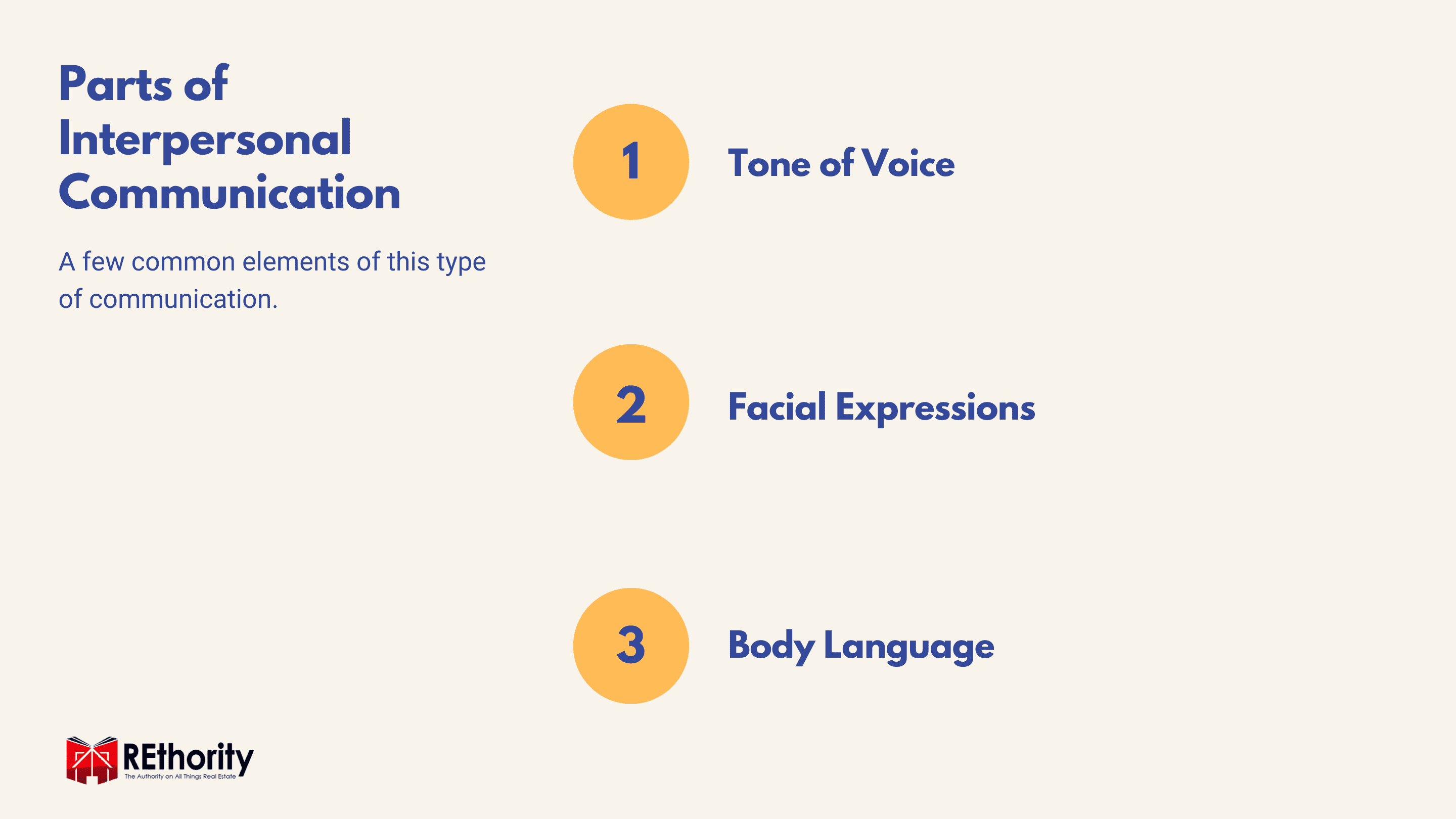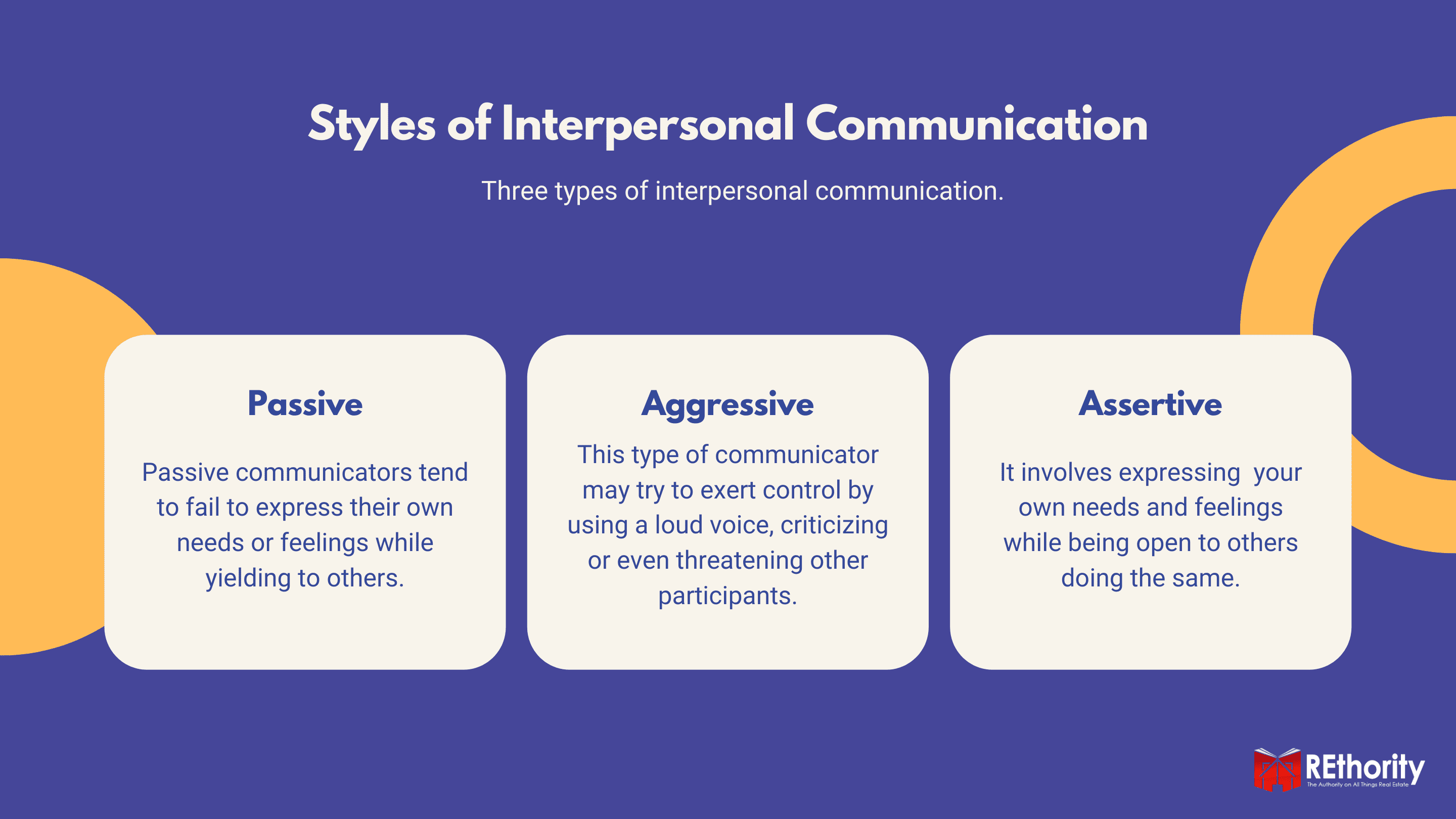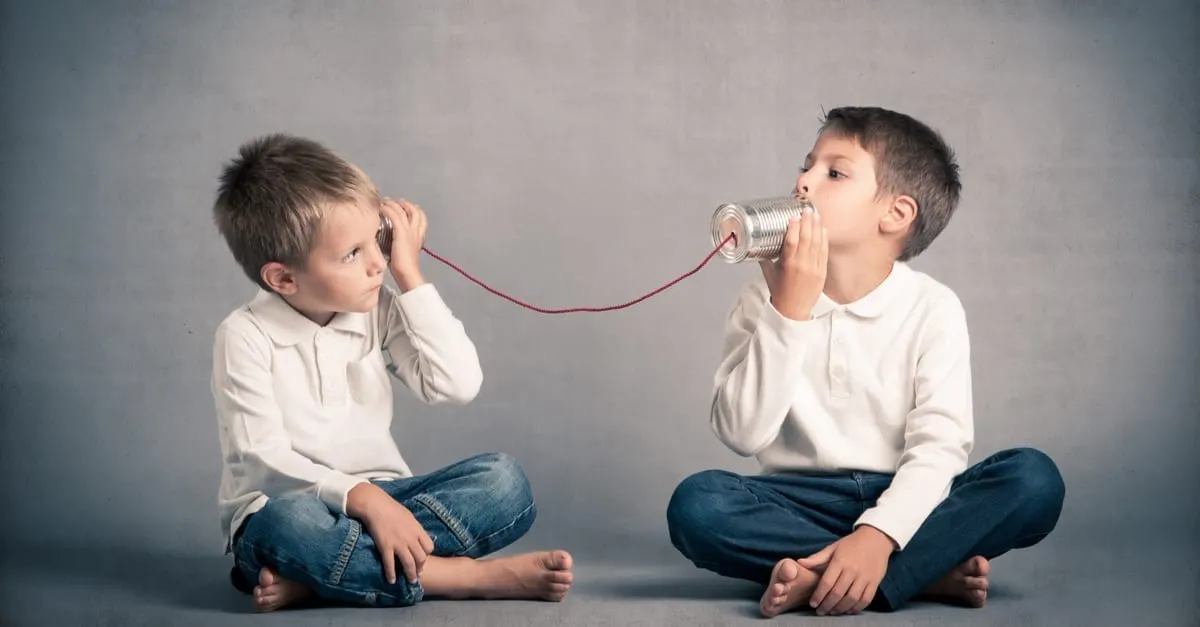Interpersonal communication is an activity every real estate professional engages in for much of his or her work day.
If there is a key skill for success in real estate, interpersonal communication may well be it. Read on to learn more about this important concept.
What Is Interpersonal Communication?
Interpersonal communication is what happens when people exchange information. In addition to the exchange of information as straightforward facts, it may consist of ideas, feelings, or other meanings.

You are using interpersonal communication any time you:
- Give information
- Gather information
- Try to influence other people
- Experience other people’s efforts to influence you
- Develop contacts
- Form relationships
- Express your needs, feelings, or viewpoints
- Try to understand others’ needs, feelings, and viewpoints
- Participate in conflict resolution, decision-making, or problem solving
Interpersonal communication is more than just words. It also consists of the participants’ facial expressions, body language, tone of voice, and gestures.
Interpersonal communication is almost constantly occurring at work and in social or family situations. Some business situations in which interpersonal communication plays a big role include:
- Staff meetings
- Property showings
- Sales calls
- Job interviews
- Water cooler chats
- Performance reviews
These examples of interpersonal communication can be done face-to-face, of course. But interpersonal communication may also happen in other ways, including when people:
- Exchange emails or text messages
- Talk on the phone, including using voice mail
- Participate in video conferences
- Like or comment on someone’s social media post
Not all communication is considered interpersonal communication. It’s usually viewed as one-to-one communication between two people.
If you give a speech or deliver a training lecture in a classroom, that wouldn’t be considered interpersonal communication.
An article for the local newspaper and an ad on Facebook are examples of mass communication, not interpersonal communication.
Parts of Interpersonal Communication
The words we use when talking or writing to someone else represent just part of the content of interpersonal communication. Our message also gets delivered by:
- Tone of voice
- Facial expressions
- Body language
- Gestures
Each of these non-verbal messages can be as important as or more important than the words we use. Non-verbal communication reveals otherwise hidden feelings and emotions.

People aren’t always aware of non-verbal communication. However, non-verbal messages are always being conveyed, even if both parties are silent.
The words being spoken contain the message the sender wants to convey. The non-verbal cues may reveal another unintentional message that reinforces or contradicts the words.
It’s a good idea to keep in mind the fact that interpersonal communication is always taking place any time two people are together. Even saying nothing, including not responding to an email, conveys a message of its own.
Interpersonal Communication Concepts
Interpersonal communication has been carefully studied and analyzed by scientists and researchers. Here are some of the interpersonal communication concepts discussed in communication theory.
Two-Way Process
Interpersonal communication is usually a two-way process. Both parties are sending and receiving messages constantly, using both verbal and non-verbal means.
For instance, while one person talks, the other may look inattentively out the window. This clearly conveys a message of its own.
Sometimes interpersonal communication can be one-way. When a broker tells an agent in the office to hold an open house on a property, for instance, no reply may be expected.
Noise
Noise is always present in interpersonal communication. It’s interference that causes a message to be garbled, incomplete, or not received at all.
Noise can be physical, as in the case of a static-filled phone line. It can also be psychological or semantic, as when someone uses technical jargon you don’t understand.
Cultural differences can be a major source of noise. Noise can’t be completely eliminated, but it can be reduced and controlled.
Feedback
Feedback consists of messages from the receiver about the messages from the sender. When two people talk face-to-face, feedback shows up as nods, frowns, shrugs, and other non-verbal communication.
Feedback can also be explicit, such as when someone responds dismissively or argumentatively to a message. It’s also two-way, and, in the case of face-to-face communication, it’s simultaneous.
Channel
The physical manner of carrying a message is also important. This is known as the channel.
In face-to-face communication, there are two channels: speech and vision. When talking by phone, speech is the only channel.
The choice of channel is important and can carry its own meaning. If a broker announces a layoff by email, it communicates a lack of care, no matter what the email’s words say.
Context
Context is the environment in which communication happens. The context can influence the content and style of communication.
For instance, you communicate differently when you’re in the office than you do when standing in the backyard of a property. The social context also matters. You speak differently to a colleague than to a customer.
Roles, responsibilities, status, expectations, and emotional climate are also part of the context. This context influences all communication.
It’s important to consider context when engaging in interpersonal communication. Most of us do this automatically, without thinking of it. But when a message isn’t received effectively, the reason may be that the context wasn’t formulated correctly.
Synchronous and Asynchronous Communication
Face-to-face communication, telephone calls, and FaceTime meetings are synchronous. Messages are received as soon as they are sent. Feedback also happens at the same time.
Emails, texts, voice mail, faxes, and snail mail are all asynchronous. The message is sent, and some time goes by before it’s received and a reply, if any, is sent back.
Synchronous communication carries more information than asynchronous communication, especially if it’s face-to-face. Synchronous communication helps build interpersonal relationships because it’s richer and more spontaneous.
Asynchronous communication lets both parties think about messages before sending them. This makes messages more clear and complete. However, it takes longer to complete a series of asynchronous communications due to the time lag.
Interpersonal Communication Errors
Anytime a misunderstanding occurs, it could be due to a failure of interpersonal communication. Because effective communication has so many parts, there are lots of ways things can go wrong, including:
- The sender doesn’t have a clear idea of what he or she is trying to communicate.
- The sender knows what he or she wants to say but can’t find the right words.
- The receiver isn’t paying attention.
- The receiver misinterprets a word or non-verbal communication.
- Communication gets interrupted by, for instance, a dropped call or email sent to a spam folder.
- The receiver doesn’t provide feedback.
The consequences of failed interpersonal communication can be serious. In addition to wasting time, it can alienate employees or co-workers, drive away customers, or create bad feelings toward the company or the individual.
Styles of Interpersonal Communication
There isn’t just one way to communicate. People tend to favor various communication styles. There are four widely recognized styles of interpersonal communication:
Passive
The passive communication style is one of indifference. Passive communicators tend to fail to express their own needs or feelings while yielding to others.
Passive communication can produce misunderstandings and lead to resentment. Signs of passive communication include a lack of eye contact and phrases such as “It doesn’t matter.”
Aggressive
Aggressive communication involves dominating others. This type of communicator may try to exert control by using a loud voice, criticizing, or even threatening other participants.
These people are often leaders and can be seen as can-do sorts who command respect. They may use phrases such as “You’re wrong” and “It’s your fault.”

Passive-Aggressive
Passive-aggressive communicators seem to be passive and uncaring. However, they are actually feeling and expressing resentment or anger in less visible ways.
Passive-aggressive communication may consist of using the silent treatment, spreading rumors, or actual sabotage. If you hear something like, “That’s okay with me, but others may not like it,” it might be a sign of passive-aggressive communication.
Assertive
The assertive style is generally seen as the most effective. It involves expressing your own needs and feelings while being open to others doing the same.
Assertive communicators may seem to be after a win-win that balances everyone’s rights, wishes, and feelings. They often use “I” statements to own up to feelings without blaming others. For example, “I feel irritated when you show up late for a meeting.”
Interpersonal Communication Skills
You can evaluate your interpersonal communication skills by asking yourself how others receive your messages. If your messages are often misunderstood, you may need to improve your interpersonal skills.
If you need to, you can learn to be more effective at interpersonal communication. Here are five skills that can promote good communication:
- Express your viewpoints, needs, and feelings to others.
- Be open to the viewpoints, needs, and feelings that others express.
- Be able to say “no” when appropriate.
- Own your feelings and viewpoints by using “I” statements rather than “you” statements.
- Maintain eye contact when communicating.
Many other interpersonal communication skills can also be developed. Active listening and expressing empathy, for instance, are teachable skills for more effective interpersonal communication.
Interpersonal Communication in a Nutshell
Interpersonal communication is used constantly by real estate professionals at work, at home, and in social settings.
Developing strong interpersonal communication skills is nearly essential for a successful, enjoyable real estate practice and life in general.

